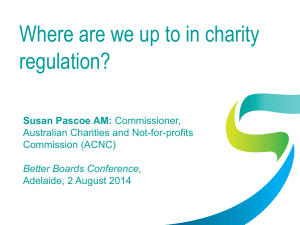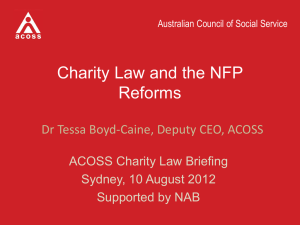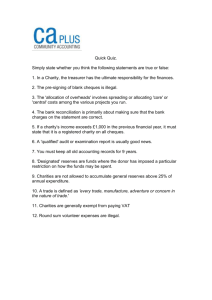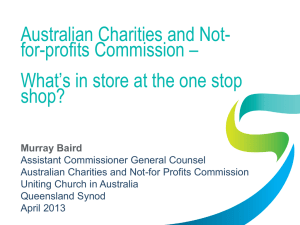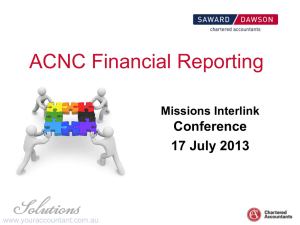20130308_ACNC presentation to CFECFW NFP Industry Day
advertisement
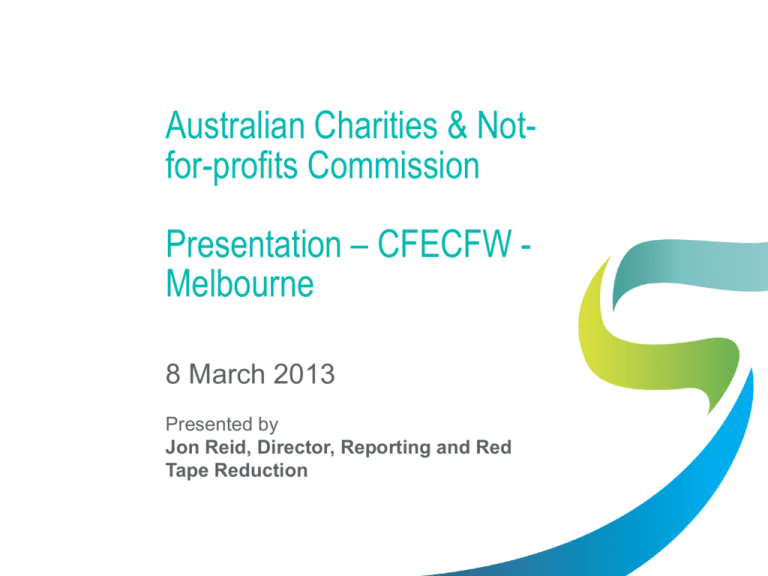
Australian Charities & Notfor-profits Commission Presentation – CFECFW Melbourne 8 March 2013 Presented by Jon Reid, Director, Reporting and Red Tape Reduction Overview of Topics • • • • • • • Introduction to the ACNC Key activities of the ACNC Obligations of charities to the ACNC ACNC Reporting Framework Reduction Initiatives Education and compliance Comments and questions What is the Australian Charities and Not-for-profits Commission? The ACNC is the independent national regulator of charities. • Established on 3 December 2012 • 56,608 registered charities. The ACNC: • registers organisations as charities • helps charities understand and meet their obligations through information, guidance, advice and other support • maintains the ACNC Register • works with governments and government agencies across jurisdictions to develop a simplified reporting framework. ACNC object 1: Maintain, protect and enhance public trust and confidence in the Australian not-for-profit sector. ACNC object 2: Support and sustain a robust, vibrant, independent and innovative Australian not-for-profit sector. ACNC object 3: Promote the reduction of unnecessary regulatory obligations on the sector. ACNC object 3. Promote the reduction of unnecessary regulatory obligations on the sector. • ACNC Reporting and Red Tape Reduction Directorate • ACNC Chair Reducing Regulatory NFP Duplication Working Party with the DPC • Data Standardisation – adoption of the National Standard Chart of Accounts (NSCOA) and alignment with Standard Business Reporting (SBR) • Charity Passport – progressively implemented from July 2014 - ACNC collect data from registration and AIS and provide to authorised Comm’th agencies = key element of report-once, use often. The ACNC Register • free, online, public register of ACNC registered charities at acnc.gov.au. Initial information on the ACNC Register includes the charity’s: • legal name • Australian Business Number (ABN), which links to their record on ABN Lookup. This record includes basic information such as the types of tax concessions your organisation receives and whether it has the deductible gift recipient (DGR) status • state or territory of registration. – continued… The ACNC Register In future, the ACNC Register will also list: • business address and contact details • the type of charity it is registered as • registration date • responsible person details (including names and positions) • a copy of the governing rules • the annual information statements provided to the ACNC, including financial reports and audit reports if the charity is medium or large and therefore required to provide these • enforcement action taken by the ACNC (such as warnings, directions, or removal of director) ACNC Mailout Staged mailout to 56,000 charities previously registered with the ATO • • • • Commencing 29 January 2013 Form to capture information from you in one interaction The form is also available online as a fillable pdf Information we receive will help us update the ACNC Register • Please call us if you do not receive the letter by mid-March 2013 Obligations to the ACNC Obligations vary depending on the charity’s size • Small charities do not need to provide as much information as medium or large charities. A charities size is determined by its annual revenue • small – annual revenue less than $250 000 • medium – annual revenue between $250 000 and $1 million • large – annual revenue is $1 million or more. Obligations to the ACNC continued To maintain ACNC registration, all registered charities need to: • notify us of certain changes, such as: – service address, legal name, governing body members, governing rules • keep records – financial records, operational records • report to us each year • meet governance and external conduct standards from 1 July 2013. • Some exemptions for basic religious charities and non-government schools. Timeline for reporting Financial reporting; governance standards and external conduct standards Regulations expected to come into effect under the ACNC Act ACNC Act received royal assent and ACNC commences operation as Australian charities regulator Registered charities have 6 months from July 2014 to provide first full annual information statement (including financial report) to the ACNC Registered charities have 6 months from July 2013 to submit a basic annual information statement (nonfinancial information) to the ACNC First financial reporting year 3 Dec 2012 March 2013 July 2013 New statutory definition of a charity expected to be introduced into Commonwealth law October 2013 January 2014 March 2014 July 2014 Transitional Annual Information Statement (TAIS) 2012-2013 • All registered charities have to submit an AIS • Legislative requirements: – Recognised Assessment Activity – Objects of the ACNC Act: • The AIS will be brief and it will cover information that charities already know, such as: – how the charity works towards its charitable purpose – the number of volunteers and paid staff – the type of people who benefit from the charity • We will pre-populate the AIS and first AIS due six months after the 2012–13 reporting period • There are penalties for not filing the TAIS or for deliberately providing misleading information 2013-2014 AIS • Due for lodgement by 31 December 2014 (unless a SAP applicable) • Will include financial and non-financial information – Proportional to charity size • Aligned to National Standard Chart of Accounts (NSCOA) and Standard Business Reporting (SBR) • Consultation with government and the sector to be undertaken Proposed standards for financial reports • Reporting framework is proportional – Small charities/BRCs are exempt from financial reports – Medium charities must prepare a financial report which can be reviewed rather than audited – Large charities must prepare an audited financial report • Medium and large entities will generally need to apply accounting standards Transitional arrangements • Commissioner may accept statements and financial reports lodged with other Government agencies as meeting the reporting requirements of an AIS or an annual financial report (subject to conditions) • Financial reports given under the Schools Assistance Act 2008 must be treated by the ACNC as an annual financial report (AIS still required unless above general transition applies) Progress in red tape reduction • Streamlined Reporting Working Groups across C’wlth (eg DEEWR, ISCA, ACARA, NCEC for non-govt schools) • Commonwealth Grant Guidelines have been amended to improve and simplify interactions around grants between the Government and the sector • Working with other regulators (eg ASIC and ORIC) to remove or minimise duplication • Collaborating with State and Territory government agencies to minimise duplicated regulatory obligations wherever possible (eg SA) • Annual Report to Parliament to map progress in achieving meaningful red-tape reduction for charities. NSCOA & SBR • QUT developed NSCOA in 2002 • COAG agreed to an implementation plan for adoption of NSCOA for NFPs by July 2010 where possible • SBR Involves Commonwealth/State/Territory governments, software developers and service providers (accountants/book keepers)* • “Common reporting language based on international standards and best practice” • Aimed at “removing unnecessary and duplicated information from government forms” *Source: www.sbr.gov.au Proposed governance standards • Standards will be principles-based and specify the outcome that charities need to achieve rather than the process • Proposed standards: – 1. Purposes and not-for-profit nature of a charity; – 2. Accountability to members; – 3. Compliance with Australian laws; – 4. Responsible management of financial affairs; – 5. Suitability of responsible entities; and – 6. Duties of responsible entities (including ‘protections’) Compliance - When and how we will act Act based on risks and evidence • Begin by assuming honesty • Use least coercive powers to address concerns • Options include: • advice, education, support • no-action letters • referrals – collaborating with other regulators • administrative penalties • warnings • directions • enforceable undertakings • injunctions • suspension/removal • revocation Regulatory pyramid of compliance and support Examples: Misuse of charity for serious criminal purposes (including financing terrorist activities) or significant private benefit Examples: Entry into financial transactions that risk insolvency; Involvement in illegal activity; Private benefit obtained by a board member. Examples: Evidence of excess financial benefit to owners; evidence of tax evasion. Examples: Repeated failure to lodge documents on time; innocent mistake as to how many board members are needed to make a decision. Examples: Forgetting to lodge a statement or report; making a minor mistake in a financial report; common mistakes or misunderstandings. Factors to consider • Type of problem • What/who at risk • Likelihood and frequency • Potential impact • Risk profile • Behaviour of those responsible What other factors should we consider? What do you see as the key risks to public trust and confidence that we should focus on? Finding out more: www.acnc.gov.au Providing you with access to information is a priority for us • • • • • • • Weekly Commissioner Column (sent to 6,193 subscribers) Media alerts and releases and newsflashes Aboriginal Liaison officers podcasts and videos – coming soon Phone: 13 ACNC (13 22 62) 8 am to 8 pm AEDST Email: advice@acnc.gov.au Social media: facebook.com/acnc.gov.au twitter.com/acnc_gov_au youtube.com/ACNCvideos
